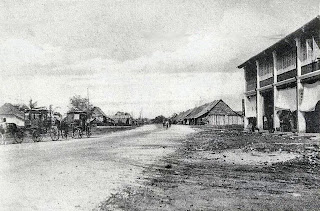Salam. Jumpa lagi kita dalam blog aku ini. Nampaknya korang dah mula menunjukkan minat terhadap sejarah. Tahniah, kerana hanya apabila kita mengambil iktibar daripada apa yang telah berlaku, maka kehidupan kita hari ini dan hari-hari mendatang akan lebih bermakna. Kerana apa? Kerana kita dah ambil teladan benda-benda atau peristiwa yang baik-baik dan kita jadikan sempadan hal atau peristiwa yang membawa keburukan dalam hidup ini. Yang terbaik, ikutlah perjalanan hidup junjungan besar kita Saidina Muhammad Rasulullah (saw), nabi dan rasul akhir zaman ,agar kita tidak tersesat atau disesatkan oleh syaitan-syaitan berupa manusia mahupun jin.
Sesungguhnya, segala takdir itu adalah ketentuan daripada Allah swt. Memang kita pernah dijajah, tunduk kepada kemahuan bangsa-bangsa keparat, Inggeris dan Jepun, tetapi kehidupan harus diteruskan. Sememangnya ada hikmah di sebalik penjajahan ini. Sultan kini sedar baginda hanyalah boneka atau kuda kayu Residen Inggeris, dengan cuma menerima elaun sebanyak 2,000 pound sterling setahun. Baginda hanya wujud di khalayak ramai dalam upacara-upacara rasmi kerajaan dan keagamaan serta adat istiadat Melayu sahaja. Rakyat lebih mengenali pengurus-pengurus estet, pendaftar di pejabat tanah, Pegawai Daerah, OCPD di balai polis daerah yang semestinya berbangsa Inggeris daripada Orang Besar Daerah yang menjadi wakil sultan di setiap daerah. Keturunan diraja tiada keistimewaannya lagi. Mereka kini setaraf dengan orang lain, tiada beza. Cuma panggilan Engku, dan patik sekadar panggilan hormat terhadap golongan bangsawan ini suatu masa dahulu. Realitinya, yang berkuasa Inggeris, bukan Sultan.
Tapi ada baiknya juga penjajahan ini. Tiada lagi hamba tebusan yang menjadi amalan biasa golongan diraja ini. Segala harta khazanah negeri kini milik rakyat, bukan lagi milik sultan. Pembangunan di sana sini. Walaupun Inggeris itu penyamun, dan sememangnya rakyat sendiri mengerti, kehidupan rakyat semakin baik. Melayu dulu yang penuh kepercayaan tahyul dan tolol kini menjadi Melayu moden yang berilmu serta mengikut peredaran peradaban manusia zamannya. Negeri diurustadbir sebaiknya oleh Inggeris. Walaupun ada yang akan berkata, umpama keluar mulut harimau, masuk mulut buaya, rakyat tidak rugi apa-apa kerana sebelum ini pun mereka tidak pernah memiliki apa-apa kekayaan negeri pun. Hanya kehidupan kais pagi makan pagi,kais petang makan petang, sebelum mata terpejam ,menyahut seruan Ilahi.
Wow, panjang juga intro aku kali ini. Maaf, aku tidak berniat nak 'sekolahkan' korang semula. Maklumlah aku dah terbiasa begitu di sekolah kerana aku seorang guru@pendidik.Hihihi...jangan marah.
Kali ini aku nak bawa korang mengimbas kembali suasana di Klang sekitar 1970-an dan awal 1980-an. Klang dan Telok memang tak dapat dipisahkan. ibarat irama dengan lagu. Sememangnya TPG di bawah lingkungan pengaruh Klang. Ramai orang Telok bekerja dan bersekolah di Klang atau Port Klang. Ramai juga yang mencari barang keperluan harian atau bulanan mereka di Klang. Bahkan di Klanglah mereka berhibur. Dengan jarak hanya 10 batu (16 km),Telok sebahagian daripada Klang walaupun terletak dalam daerah yang berbeza. Satu mercu tanda Klang yang kini tiada lagi ialah Pasar Besar. Terletak tidak jauh dari tebing Sungai Klang, kedudukannya sememangnya strategik kerana betul-betul di tengah-tengah aktiviti ekonomi Klang masa itu. Secara tepatnya, lokasi pasar besar ini di tebing Klang Utara, berhampiran Pasar Jawa dan Emporium Makan. Sekarang pasar ini dah tak wujud lagi. Pasar borong Klang sekarang dah dipindahkan ke Jalan Meru, sebelah Klang Parade. Bila? Korang tanyalah sama itu MPK.
 Aku tahu pasar ini dah lama wujud kerana Klang sudah ada sebelum kedatangan British lagi. Cuma aku nak fokuskan ketika zaman Inggeris tadbir Klang sahaja kerana ada data-data sejarahnya. Sebagaimana di bandar-bandar besar seperti di Taiping, Ipoh, Kuala Lumpur, Seremban dan sebagainya,ketika era kolonial dulu, lokasi pasar telah dirancang dalam pelan induk pembangunan Klang. Bahkan rekabentuknya hampir sama. Ketika aku melayari internet aku bertembung gambar-gambar pasar yang terletak di Taiping dan Ipoh. Itulah juga wajah pasar Klang ketika aku kecil-kecil dahulu. Hampir sebiji! Pasr ini terdiri daripada 2 blok bangunan, satu blok sayur sahaja, lagi satu pulak blok ikan dan daging. Pasar babi memang diasingkan. Masih dalam satu bagunan tetapi berkepung. Bukanlah emak abah aku setiap hari ke sini untuk beli lauk harian, cuma kalau keluarga aku merancang untuk buat kenduri tahlil atau kesyukuran semestinya kami berbelanja di sini kerana lebih murah dan banyak pilihan.
Aku tahu pasar ini dah lama wujud kerana Klang sudah ada sebelum kedatangan British lagi. Cuma aku nak fokuskan ketika zaman Inggeris tadbir Klang sahaja kerana ada data-data sejarahnya. Sebagaimana di bandar-bandar besar seperti di Taiping, Ipoh, Kuala Lumpur, Seremban dan sebagainya,ketika era kolonial dulu, lokasi pasar telah dirancang dalam pelan induk pembangunan Klang. Bahkan rekabentuknya hampir sama. Ketika aku melayari internet aku bertembung gambar-gambar pasar yang terletak di Taiping dan Ipoh. Itulah juga wajah pasar Klang ketika aku kecil-kecil dahulu. Hampir sebiji! Pasr ini terdiri daripada 2 blok bangunan, satu blok sayur sahaja, lagi satu pulak blok ikan dan daging. Pasar babi memang diasingkan. Masih dalam satu bagunan tetapi berkepung. Bukanlah emak abah aku setiap hari ke sini untuk beli lauk harian, cuma kalau keluarga aku merancang untuk buat kenduri tahlil atau kesyukuran semestinya kami berbelanja di sini kerana lebih murah dan banyak pilihan. Untuk maklumat korang yang tak familiar dengan beberapa unit ukuran dan timbangan masa itu, di sini aku 'sekolahkan' korang sikit. Hehehe...
1 pikul= 100 kati
1 kati=600 gram
1 lb.(pound)= 500 gram
1 ela= 0.91 meter
Yang lain tu, lu pikirlah sendiri.HAHAHA..Oklah, sampai kat sini sahaja pertemuan kita, jumpa lagi lain kali, insyaAllah.
Pasar Basar Klang
Bandingkan pula dengan harga sekarang 2008
dan 2013

















.JPG)













